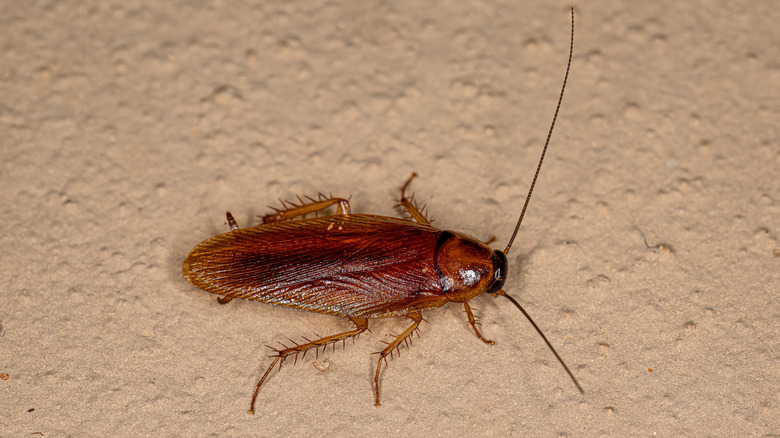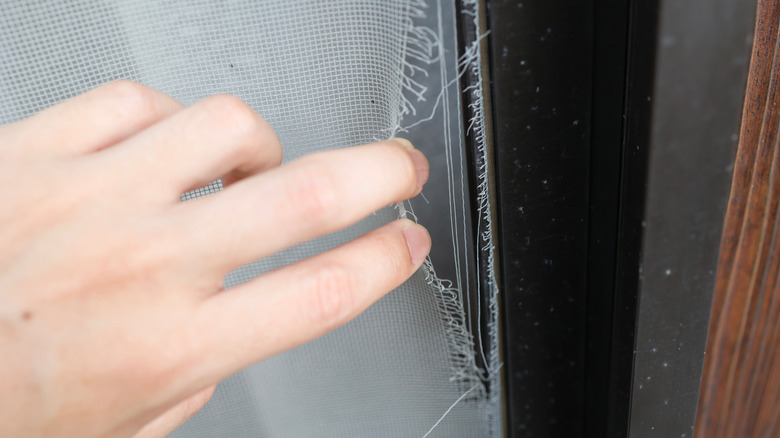This Lighting Error Is Attracting Wood Roaches To Your Home
Wood cockroaches aren't generally considered household pests. They're outdoor critters that prefer rummaging around in leaf litter over the clutter in your basement. Male wood cockroaches can fly, and during their mating season in late spring to summer, they travel short distances looking for females. The thing is, the males are attracted to artificial light at night, and this can draw them to porches and windows. Leaving your outside lights on late into a summer evening or your window curtains open instead of drawn is a wood cockroach-attracting error many people make. They don't realize that keeping things dark is one of the most effective ways to keep palmetto bugs out of your home — or, indeed, any wood cockroach species anywhere in the country.
There are 12 known species of wood cockroaches in North America, and all are native to the region. Some of the species more commonly spotted in residential areas include the Pennsylvania wood roach (Parcoblatta pennsylvanica), fulvous wood cockroach (Parcoblatta fulvescens), Virginia wood cockroach (Parcoblatta virginica), and Florida woods cockroach (Eurycotis floridana). While there's variation across species, generally, adults grow to between 0.75 and 1.25 inches in length, with males being larger than females. Like other cockroaches, they range in color from a light, white-striped tan to a dark brown-almost black. They live outdoors in wood piles, fallen logs, and other woody environments where their favorite food (yes, you guessed it, decaying wood) is plentiful. Don't confuse them with the relatively uncommon, termite-like wood-feeding cockroaches.
Why you shouldn't worry about wood cockroaches
Encountering a giant bug scurrying down your hallway or stuck in the bathtub is never pleasant, but most people have nothing to fear from the humble wood roach. Unlike other cockroach species, these insects hate indoor life. They eat wood but have no appetite for the dry, treated wood from which our home and furniture are crafted. They're also not interested in eating leftover food, sewage, or other household waste — again, unlike the infectious cockroach species more commonly considered household pests. However, less airtight and infrequently visited structures around your home, like wood piles, barns, storage areas, greenhouses, or water pump shelter boxes, are another story altogether.
Once inside, they typically run around for a bit — they're not afraid of humans — and, if they can't find a way outside again, die of dehydration and a lack of food. They can't reproduce indoors, either; a male is unlikely to find a female living indoors for all the reasons above. Occasionally, small populations are found in disused attics, but it's so rare as to be inconsequential. There is a minor worry for family members with roach allergies — known or unknown. They might react to the secretions, feces, and exuviae (molted skin), according to WebMD. The first thing you need to do if you find cockroaches of the sylvan variety in your home is help them get out. The second thing is to restrict their access in the first place.
How they get in and what to do about it
Having the lights on at night in the summer drives wood cockroaches to your front door or windows. Roaches use torn screens or gaps, foundation cracks, and vents to crawl inside. Wood roaches love bathrooms — there's lots of moisture and often a nightlight. Heavy fall rains may also drive them inside, and if you live in or near a wooded area, you'll double your chances of spotting them indoors. The same goes for those with wood fires and stoves since these critters hide in the firewood you carry inside. Occasionally, they'll hitch a ride on houseplants you've put outside in the rain or sun.
The simplest way to send roaches packing is to stop attracting them. This means turning lights on only when needed and choosing yellow lights over white. Fix tears in window and door screens, make sure they fit the frame snugly, and seal any holes. Professional extermination isn't necessary with wood roaches, but if you want to go the chemical route, treat light fixtures and entryway points with an indoor-outdoor residual spray. ePestSupply sells a 17.5-ounce can of PT 221L pressurized insecticide for $25.95, or get a 1.33-gallon container of Ortho Home Defense Insect Killer with a spray wand for $28.72 from Walmart. Firewood is a residence of choice for wood cockroaches, so carefully examine each piece before hauling it into your house. Use it quickly, too. Firewood left outside longer than a year attracts more roaches.


